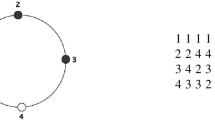Abstract
Let P be the poset k 1 × ... × k n , which is a product of chains, where n≥1 and k 1≥ ... ≥k n ≥2. Let \(M = k_1 - \sum\nolimits_{i = 2}^n {(k_i - 1)} \). P is known to have the Sperner property, which means that its maximum ranks are maximum antichains. Here we prove that its maximum ranks are its only maximum antichains if and only if either n=1 or M≤1. This is a generalization of a classical result, Sperner's Theorem, which is the case k 1= ... =k n =2. We also determine the number and location of the maximum ranks of P.
Similar content being viewed by others
References
V. B. Alekseev (1974) The use of symmetry for finding the width of a partially ordered set (Russian), Diskret. Analiz. No. 26, 20–35.
N.deBruijn, C. A.vanEbbenhorst Tengbergen, and D. R.Kruyswijk (1952) On the set of divisors of a number, Nieuw Arch. Wisk. 23, 191–193.
G. F.Clements, and B.Lindström (1969) A generalization of a combinatorial theory of Macaulay, J. Combinatorial Theory 7, 230–238.
C.Greene, and D. J.Kleitman (1978) Proof techniques in the theory of finite sets, in Studies in Combinatorics, (ed. G.-C.Rota), Math. Assoc. Amer., Washington, D.C., pp. 22–79.
J. Griggs (n.d.) The strict Sperner property, Preprint.
J. R. Griggs (1982) The Sperner property, Proc. Conference on Ordered Sets and their Applications (Lyon, 1982), to appear.
L. H.Harper (1974) The morphology of patially ordered sets, J. Combinatorial Theory 17, 44–58.
W. N.Hsieh, and D. J.Kleitman (1973) Normalized matching in direct products of partial orders, Studies in Appl. Math. 52, 285–289.
D. J. Kleitman (1974) On an extremal propert of antichains in partial orders. The LYM property and some of its implications and applications, in Combinatorics (eds. M. Hall and J. H. Van Lint), Math. Centre Tracts 55, Amsterdam, pp. 77–90.
E.Sperner (1928) Ein Satz über Untermengen einer endlichen Menge, Math. Z. 27, 544–548.
R. L.Graham and L. H.Harper (1969) Some results on matching in bipartite graphs, SIAM J. Appl. Math. 17, 1017–1022.
N. N.Katerinochkina (1978) Sets containing a maximal number of pairwise incomparable n-dimensional k-ary sets, Math. Notes 24, 696–700, translated from Matematicheskie Zametki 24, 367–374 (in Russian).
Author information
Authors and Affiliations
Additional information
Communicated by B. Sands
Research supported in part by the National Science Foundation 10/25/83.
Rights and permissions
About this article
Cite this article
Griggs, J.R. Maximum antichains in the product of chains. Order 1, 21–28 (1984). https://doi.org/10.1007/BF00396270
Received:
Accepted:
Issue Date:
DOI: https://doi.org/10.1007/BF00396270



